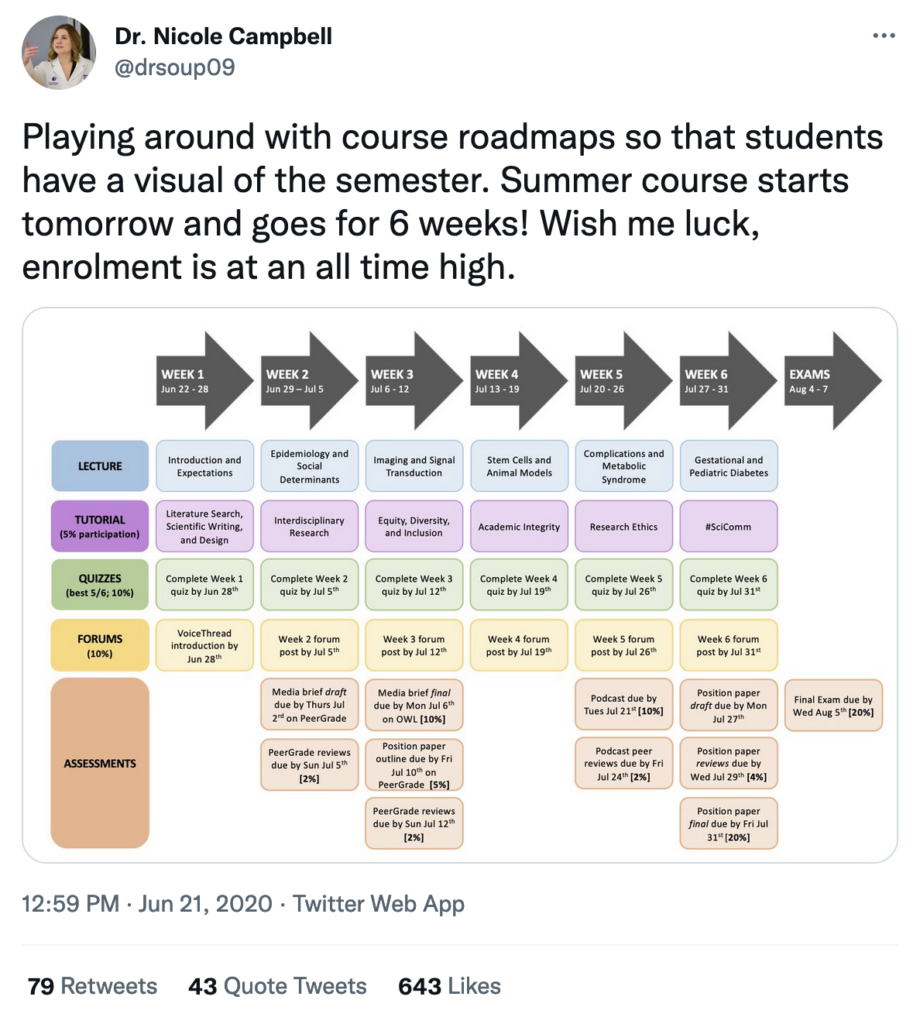Rebekah Bennetch, a Lecturer with the School of Professional Development in the College of Engineering shared her experiences Bridging her own Distance dilemmas in a recent contest entry. In this post Rebekah describes finding an online community of educators on Twitter to help fill the professional development gaps the pandemic had left her with.
While engaging in a wealth of tweets, keynotes, and an #ungraded book club Rebekah found a great way to adapt her 15-page syllabus into a visual course map that has helped students better navigate the expectations and organization of her online course. See a sample of the visual design and hear more about the opportunities Rebekah found to help Bridge the Distance.
By Rebekah Bennetch, Lecturer, School of Professional Development, College of Engineering, University of Saskatchewan.
I still remember the last day of in-person classes in March 2020 – maybe I should have paid more attention to the ominous sign that it was happening on a Friday the 13th. Soon after, I found myself with both a home office and a home classroom, and it wasn’t the easiest transition to be on my own.
I could no longer walk down the hallway to bounce ideas off my colleagues, so I had to find another space where I could find professional community: and that’s where Twitter came in. While most social media sites these days can be filled with misinformation and many unproductive thoughts, Twitter’s educational landscape has been a lifeline for me during these pandemic days.
Over the last 20 months I’ve been surprised by how much professional development I’ve been able to do through Twitter. By reading other educators’ tweets, I’ve learned about ideas about what has worked/what hasn’t in our remote, hybrid, and in-person classrooms. I have been able to listen to keynote presentations from educators from all over North America, and I participated in an #ungrading book club where I got to ask direct questions to the authors of the book.
Reading tweets can be more than just a way to pass the time – in fact, one of my courses will now be better thanks in large part to the shared ideas from a colleague at Western University, Dr. Nicole Campbell (@drsoup09). In June 2020, Dr. Campbell shared a visual course map she designed for her students. In the collaborative environment of Twitter, she also shared the map’s file with other educators.

When I read Dr. Campbell’s tweet, and then thought about my 15-page course syllabus, I was intrigued by the idea of making my content more accessible for students. Dr. Campbell’s tweet inspired me to create our own visual map to help students better navigate our asynchronous course.
300Course Roadmap-T2Adapting my syllabus into a visual map did not require too much extra work for me as an instructor, though it did require me to think differently about how I transmit content to my students. And if it wasn’t for Dr. Campbell initially sharing her idea on Twitter with other educators, I may not have been challenged to change my course for the better.
I’ve found Twitter has been both a great source of inspiration – and commiseration – as we all work through these unique days in the classroom. Social media isn’t just for sharing cat videos and memes – it can be a place for tired and isolated teachers to find ideas, and for us to not feel quite as alone.


